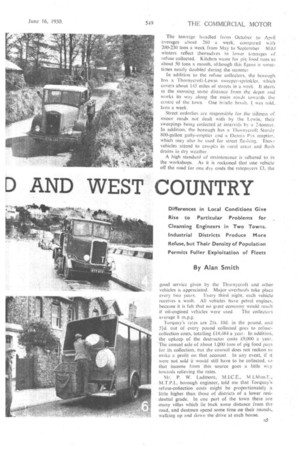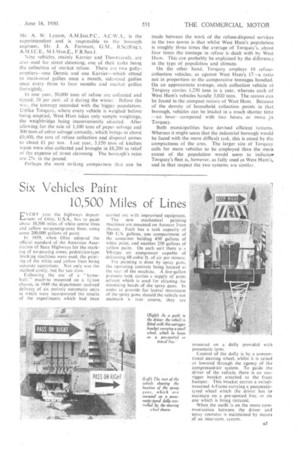CLEANSING EAST I D AND WEST COUNTRY
Page 38

Page 39

Page 40

Page 41

If you've noticed an error in this article please click here to report it so we can fix it.
Differences in Local Conditions Give Rise to Particular Problems for Cleansing Engineers in Two Towns, Industrial Districts Produce More Refuse, but Their Density of Population Permits Fuller Exploitation of Fleets
By Alan Smith REFUSE collection and disposal--among the most important functions in . a civilized community—are activities in which the methods employed and types of vehicle used vary widely Individual preferences among local authorities probably account in part for this divergence, but the absence of standardization arises mainly from the differences in locai conditions, both geographical and sociological. With this in mind, it is interesting to compare the systems evolved by sedate and pleasant Torquay, a picturesque Devonshire resort of those in the " upperincome brackets," and busy. West Ham, in London's East End, densely populated by artisans and labourers who Work in the borough's docks and factories.
Torquay has a residential population of about 50,000 and an influx of 30,000 visitors during the summer. The area covered by the municipal fleet extends over a three-mile radius and embraces 115 miles of streets, including 20 miles of class A and secondary roads. Much of the district is hilly and many of the roads are narrow. There are no factories.
Ten Thornycroft petrol-engined refuse collectors are employed. seven -of which have moving floors.
Their capacities range from 12 cubic yds. to 15 cubic yds. One S.D. vehicle is on order. Because the many narrow roads do not permit easy side-loading, all the vehicles are end-loaders, and carry baskets and sacks on the tailboard for the collection of paper salvage and bottles.
A five-day week is worked, starting each day at 7.30 a.m. and finishing at 4.30 p.m. Each vehicle, with its crew of three, including the driver, covers a different area of the town each day, and makes two rips in the morning and one in the afternoon. The collectors begin from the central depot and take their refuse to the town destructor, where it is burned.
Upon arrival at the destructor. the loaded vehicles are weighed on the weighbridge, so that records can be made of the tonnage collected Paper is unloaded and stacked while awaiting transport to pulp mills. Although during the summer the number of bottles to be disposed of increases to thousands of dozens, there is, surprisingly, no other marked effect on the cleansing department in the holiday season. More refuse is collected in winter, when people have fires.
The tonnage handled from • October to April averages about 260 a week, compared With 200-230 tons a week from May to September Mild winters reflect themselves in lower tonnages of refuse collected. Kitchen waste for pig food runs to about 50 tons a month, although this figure is sometimes nearly doubled during the summer In addition to the refuse collectors, the borough has a Thornycroft-Lewin sweeper-sprinkler, which covers about 145 miles of streets.in a week_ It starts in the morning some distance from the depot and works its way along the main roads towards the centre of the town_ One •bristle brush. 1. was -told. lasts a week.
Street orderlies are responsible for the tiaines.s of minor roads not dealt with by the Lewin, their sweepings being collected at intervals by a 2-tonner. In addition, the borough has a Thornycroft Sturdy 800-gallon gully-emptier and a Dennis Pax emptier, which may also be used for street flushing. Thes: vehicles attend to cesspits in rural areas and flush drains in dry weather.
A high standard of maintenance is adhered to in the workshops. As it is reckoned that one vehicle off the road for one day 'costs the ratepayers E.3, the good service given by the Thornycroft and other vehicles is appreciated. Major overhauls take place every two years. Every third night, each vehicle receives a wash. All vehicles have petrol engines, because it is felt that no great economy would result if 'oil-engined vehicles were used The collectors average 8 m.p.g.
Torquay's rates are 21s. 10d. in the pound, and 5id. out of every pound collected goes to refusecollection costs, totalling £14,484 a year. In addition, the upkeep of the destructor costs 19,000 a year. The annual sale of about 1,000 tons of pig food pays for its collection, but the council does not reckon to make a profit on that account. In any event, if it were not sold it would still have to be collected, so that income from this source goes a little way towards relieving the rates.
Mr. P. W. Ladmore, M.I.C.E., M LTV! WI M.T.P.I., borough engineer, told me that torquay7s refuse-collection costs might be proportionately a little higher than those of districts of a lower residential grade. In one part of the town there are many villas which lie back some distance from the road, and dustmen spend some time on their rounds; walking up and down the drive at each house. .
In West Ham, by contrast, with its rows of terraced houses, people put their dustbins outside their houses for emptying. Being a working-class district, the householders co-operate well with the dustmen.
The area covered by the West Ham authorities is much smaller than Torquay, being 4,706 acres. The population, however, is twice as great as Torquay's at its highest. Before the war it was about 300,000, although declining a little. German bombers destroyed 30 per cent. of property in the borough, and the population now stands at about 175,000, living in 36,500 houses. There are 140 miles of streets.
There are extensive docks and many factories in the borough, including one of the biggest sugar refineries in the world. Industrialization, however, does not directly affect the municipal refusecollection services. The Port of London Authority looks after the cleansing of the docks, and factories dispose of their trade refuse through sub-contractors. The local authority, however, collects from smaller factories and takes the canteen waste from the bigger plants.
Market Problems At the close of the day, the markets in the borough are in an untidy state and present One of the council's bigger burdens. From the mass of waste left, every effort is made to salvage as much as possible for conversion into pig food_ Before the war the council employed Pagefield units, using one carrier to three working containers. This system has now been almost abandoned and has been replaced by side-lbading unit vehicles.
One carrier and two containers remain to-day, but the operational relay system concomitant with the Pagefield method
remains Since the end of the war, 13 S.D. and two Karrier refuse collectors have been delivered. These belong to the borough transport department and al e hired to the cleansing, and salvage department, a book charge• being made for accountancy purposes.. The S.D. collectors are of the Newcastle type and are all normal side-loaders. Each tows a Glover, Webb and Liversidge trailer for salvage collection.
One Load Per Hour
Gangs of seven men, six of whom are loading while one is travelling to and from the controlled tip, collect refuse in a different part of the borough each day and load one vehicle in about an hour. Two vehicles work with each gang. When one is loaded, it is relieved by an empty collector and then driven to the borough's controlled tip to dump its load. A Caterpillar oilengined bulldozer levels the tip.
The relay system is worked in the residential parts of the borough, there being six gangs to the 12 S.D. units. The Karriers and an S.D., with normal accompanying crews, collect refuse from the shopping streets. The council hires out 21,000 B.S.I. dustbins to householders at a rental of 4s. a year, and lends them sandbags for paper salvage
Although dustbins in the residential districts are left outside the houses for emptying, they are often kept at the rear of shops. Men collecting from shops carry, when necessary, zinc baths into which they empty the contents of the dustbins, avoiding the necessity of returning with the bin through the shop. This method speeds up collection—an important consideration when it is remembered that a slow-moving refuse vehicle can cause much congestion in a busy shopping street.
On the street-cleansing side, the department has two Thornycroft-Lewin sweepers and one Karrier. Brushes last for about a fortnight. The Lewin sweeper collectors are used on all types of road surface, except where tarmacadam has been newly laid. These vehicles look after the main roads, street orderlies being responsible for the side roads. The mechanical sweepers also assist in the cleansing of side roads, as, for instance, when men go on holiday, or• are sick, •The street orderlies also collect kitchen waste. It has been the intention of the department to start its new employees as street orderlies, eventually to become dustmen, but many men seem to prefer the lower-paid position of sweeper to the better-paid but more energetic job of dustman. The cleansing department employs 208 men.
Mr. A. W. Lynam, A.M.Inst.P.C., A.C.W.A., is the superintendent and is responsible to the borough engineer, Mr. J. A. Formunt, G.M., B.Sc.(Eng.), A.M.1.C.E., F.R.San.t.
Nino vehicles, mainly Karrier and Thornycroft, are also used for street cleansing, one of their tasks being the collection of market refuse. There are two gullyemptiers-one Dennis and one Karrier—which attend to main-road gullies once a month, side-road gullies once every three to four months and market gullies fortnightly'.
In one year, 50,000 tons of refuse are collected and tipped, 58 per cent.. of it during the winter. Before the war, the tonnage accorded with the bigger population. Unlike Torquay, ,where every vehicle is weighed before being emptied, West Ham takes only sample weighings, the weighbridge being inconveniently situated. After allowing for the sale Of 1,100 tons of paper salvage and 300 tons of other salvage annually, which brings in about £9,400, the cost of refuse collection and disposal comes to about £1 per ton. Last, year, 3,150 tons of kitchen waste were also collected and brought in £8,200 in relief of the expense of street cleansing. The borough's rates are 25s. in the pound.
Perhaps the most striking coMparison that can be made between the work of the refuse-disposal services in the two towns is that whilst West Ham's population is roughly three times the average of Torquay's, about four times the tonnage in refuse is dealt with by West Ham. This can probably be explained by the difference in the type of population and climate.
On the other hand, Torquay employs 10 refusecollection vehicles, as against West Ham's 17—a ratio not in proportion to the comparative tonnages handled. On an approximate average, each collection vehicle at Torquay carries 1,250 tons in a year, whereas each of West Ham's vehicles handle 3,000 tons. The reason can be found in the compact nature of West Ham. Because of the density of household collection points in that borough, vehicles can be loaded in a much shorter time —an hour—compared with two hours or more ,in Torquay.
Both municipalities have devised efficient systems. Whereas it might seem that the industrial borough would be faced with the more difficult task, this is eased by the compactness of the area. The larger size of Torquay calls for more vehicles to be employed than the mere extent of the population would seem to indicate" Torquay's fleet is, however, as fully used as West Ham's, and in that respect the two systems are similar.












































































